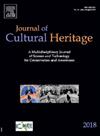A novel nanocomposite hydrogel system for synergistic paper deacidification and reinforcement
IF 3.3
2区 综合性期刊
0 ARCHAEOLOGY
引用次数: 0
Abstract
Acidification is one of the major factors exacerbating paper deterioration, rendering documents brittle and prone to crumbling—even under gentle handling. This process is widespread among paper-based artifacts and progresses rapidly, posing a serious threat to their long-term preservation. As such, the need for effective deacidification and reinforcement methods in the conservation and restoration of paper artifacts is becoming increasingly urgent. This study proposes an innovative dual-purpose nanocomposite system, GG-C-M, achieving both deacidification and reinforcement effects on paper artifacts. The system is composed of a hydrogel matrix loaded with deacidifying and structural reinforcement agents. We analyzed the physicochemical properties—including microscopic morphology, pH, alkali reserves, and tensile strength—of acidified, dry heat-aged, and UV-aged paper samples before and after treatment with GG-C-M. Our results show that GG-C-M effectively treats severely acidified paper (pH ≤ 5.0), restoring it to a mildly alkaline state as well as improving their mechanical properties. The treatment significantly improves those physiochemical properties, while also mitigating adverse macroscopic and microscopic side-effects such as edge curling, increased thickness, whitening, and particle residue—issues commonly observed after direct application of sodium carboxymethyl cellulose nano-Mg(OH)₂ (C-M) dispersion. The proposed nanocomposite system offers advantages such as biocompatibility, localized treatment, controllable swelling, strong adsorption, and easiness of application.

一种新型纳米复合水凝胶协同纸张脱酸强化体系
酸化是加剧纸张变质的主要因素之一,即使在温和的处理下,也会使文件变脆,容易碎。这一过程在纸质文物中普遍存在,且进展迅速,对其长期保存构成严重威胁。因此,在保护和修复纸质文物方面,需要有效的脱酸和加固方法正变得越来越迫切。本研究提出了一种创新的双重用途纳米复合材料体系,GG-C-M,实现了纸制品的脱酸和强化效果。该系统由负载脱酸剂和结构增强剂的水凝胶基质组成。我们分析了GG-C-M处理前后酸化、干热老化和紫外线老化纸样品的理化性质,包括微观形貌、pH值、碱储量和抗拉强度。研究结果表明,GG-C-M能有效地处理pH≤5.0的严重酸化纸,使其恢复到轻度碱性状态,并改善其机械性能。该处理显著改善了这些物理化学性能,同时也减轻了宏观和微观的不良副作用,如卷曲、厚度增加、美白和颗粒残留等问题,这些问题是直接使用羧甲基纤维素钠纳米mg (OH) 2 (C-M)分散体后常见的。该纳米复合材料具有生物相容性好、局部处理、溶胀可控、吸附性强、易于应用等优点。
本文章由计算机程序翻译,如有差异,请以英文原文为准。
求助全文
约1分钟内获得全文
求助全文
来源期刊

Journal of Cultural Heritage
综合性期刊-材料科学:综合
CiteScore
6.80
自引率
9.70%
发文量
166
审稿时长
52 days
期刊介绍:
The Journal of Cultural Heritage publishes original papers which comprise previously unpublished data and present innovative methods concerning all aspects of science and technology of cultural heritage as well as interpretation and theoretical issues related to preservation.
 求助内容:
求助内容: 应助结果提醒方式:
应助结果提醒方式:


